 |
 |
|
 |
|
 |
|  |
|  |
|
 |
|
 |
|  |
|  |
|
 |
Hi,
Here is an isosurface blob using a exponential density function. Shown
is the same blob at different thresholds. Seems relatively smooth --
can anyone suggest a good test that causes non-smooth areas on
normal blobs?
(oh, the noise is just some f_noise3d to add interest to the
image, the blobs really are smooth)
--John
Post a reply to this message
Attachments:
Download 'blobs.jpg' (30 KB)
Preview of image 'blobs.jpg'
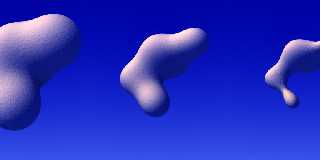
|
 |
|  |
|  |
|
 |
|
 |
|  |
|  |
|
 |
John Williamson wrote:
> Hi,
>
> Here is an isosurface blob using a exponential density function. Shown
> is the same blob at different thresholds. Seems relatively smooth --
> can anyone suggest a good test that causes non-smooth areas on
> normal blobs?
Wow, they are very smooth indeed. This seems quite promising. What was the
render time?
It is really quite easy to get non-smooth results with blobs. The attached
image shows the 2nd-derivative artifact quite clearly, especially in the
shading. Here's the source
// --- --- ---
global_settings { assumed_gamma 1 }
camera { location <0,12,0> look_at 0 }
light_source { <100,300,-100> 1 }
#declare i = 0;
#while(i < 3)
blob {
threshold i/6+0.1
sphere { <-2,0,-1>,3,0.6 }
sphere { <3,0,-0>,3,0.7 }
sphere { <1,0,-2>,2,0.9 }
pigment { rgb 1 }
finish { phong 0.9 diffuse 0.8 }
scale 0.6
rotate 90*y
translate (i*4-4)*x
}
#declare i = i + 1;
#end
sky_sphere {
pigment {
planar
color_map {
[0 rgb <0.1,0.1,0.5> ]
[1 rgb 1 ]
}
}
}
Post a reply to this message
Attachments:
Download 'blob_artifact.jpg' (19 KB)
Preview of image 'blob_artifact.jpg'
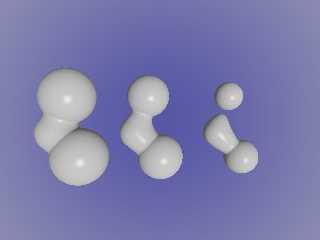
|
 |
|  |
|  |
|
 |
|
 |
|  |
|  |
|
 |
Hi,
> Wow, they are very smooth indeed. This seems quite promising.
> What was the render time?
About 30s on a 1.4Ghz Athlon. I'll have a go at reproducing something
similar to the scene you sent with exponential blobs.
--John
Post a reply to this message
|
 |
|  |
|  |
|
 |
|
 |
|  |
|  |
|
 |
Hi again,
> I'll have a go at reproducing something
> similar to the scene you sent with exponential blobs.
Right, just stuck in the values from the scene you provided (doesn't
necessarily make sense, but still), here's the result. Rendered in
40s on 1.4Ghz Athlon. Source below.
global_settings { assumed_gamma 1 }
camera { location <0,12,0> look_at 0 }
light_source { <100,300,-100> 1 }
#declare fn_gauss = function(x,y,z,r) { - exp(-(x*x + z*z + y*y)/r) }
#declare fn_blob = function(x,y,z) { (fn_gauss(x+2, y, z+1, 3) * 0.6 +
fn_gauss(x-3, y, z, 3) * 0.7 +
fn_gauss(x-1, y, z+2, 2) * 0.9)/4 }
#declare i = 0;
#while(i < 3)
isosurface {
function { fn_blob(x, y, z) } // alternative
declared function
contained_by { box { -5, 5 } } // container shape
threshold -0.095 + i*0.02
accuracy 0.01 // accuracy of
calculation [0.001]
max_gradient 0.3 // maximum
gradient the function can have [1.1]
pigment { rgb 1 }
finish { phong 0.9 diffuse 0.8 }
scale 0.6
rotate 90*y
translate (i*4-4)*x
}
#declare i = i + 1;
#end
sky_sphere {
pigment {
planar
color_map {
[0 rgb <0.1,0.1,0.5> ]
[1 rgb 1 ]
}
}
}
Post a reply to this message
Attachments:
Download 'gausstest.jpg' (12 KB)
Preview of image 'gausstest.jpg'
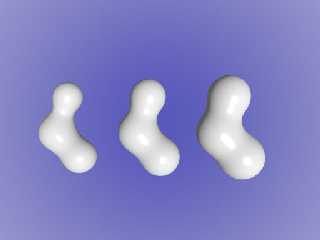
|
 |
|  |
|  |
|
 |
|
 |
|  |
|  |
|
 |
On Sun, 13 Oct 2002 21:35:25 +0100, John Williamson
<wil### [at] dcs gla gla ac ac uk> wrote:
I'm attaching a POV file to this message. It isn't really an example
of a non-smooth blob, but it is one of the more unusual blob shapes I
have come up with. It really seems counter-intuitive to the way that
blobs were supposed to work. I'd be curious to see what you can do
with an exponential blob render, using my scene file.
thanks,
Glen Berry
Later,
Glen
7no### [at] ezwv uk> wrote:
I'm attaching a POV file to this message. It isn't really an example
of a non-smooth blob, but it is one of the more unusual blob shapes I
have come up with. It really seems counter-intuitive to the way that
blobs were supposed to work. I'd be curious to see what you can do
with an exponential blob render, using my scene file.
thanks,
Glen Berry
Later,
Glen
7no### [at] ezwv com (Remove the numeral "7") com (Remove the numeral "7")
Post a reply to this message
Attachments:
Download 'GB_Strange_Blob.jpg' (10 KB)
Download 'GB_Strange_Blob.pov.txt' (1 KB)
Preview of image 'GB_Strange_Blob.jpg'
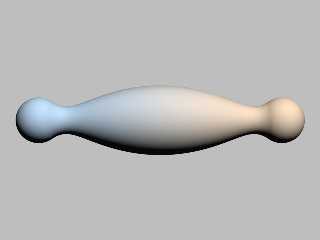
|
 |
|  |
|  |
|
 |
|
 |
|  |
|  |
|
 |
Hi,
>
> I'm attaching a POV file to this message. It isn't really an example
> of a non-smooth blob, but it is one of the more unusual blob shapes I
> have come up with. It really seems counter-intuitive to the way that
> blobs were supposed to work. I'd be curious to see what you can do
> with an exponential blob render, using my scene file.
Hmm, that's _very_ counterintuitive with standard blobs! Here's a quick
replacement with exp blobs. I just copied the values straight in, and it
seems to work fairly sensibly. I had to fake the texture with a x
gradient
though.
Scene and image below.
--John
#global_settings { assumed_gamma 1.0 }
background { color rgb 0.667 }
camera { perspective
angle 15
location <0, 0, -10>
look_at <0, 0, 0>
}
light_source { <10, 20, -30> color rgb 1 }
#declare SB_Fin = finish { ambient 0.01 diffuse 0.99 }
#declare fn_gauss = function(x,y,z,r) { - exp(-(x*x + z*z + y*y)/r) }
#declare fn_blob = function(x,y,z) { (fn_gauss(x+1, y, z, 1.9) * 0.68 +
fn_gauss(x-1, y, z, 1.9) * 0.68)
}
isosurface {
function { fn_blob(x, y, z) }
contained_by { box { -5, 5 } }
threshold -(2/3)
accuracy 0.001
max_gradient 2.0
finish { SB_Fin }
pigment { gradient x
color_map {
[0.0 color rgb <1.0, 0.85, 0.7>]
[1.0 color rgb <0.7, 0.85, 1.0>]
}
scale 3
translate -1.5*x
}
scale 0.9 // compensate for exp func.
}
Post a reply to this message
Attachments:
Download 'gb_strange_blob_exp.jpg' (9 KB)
Preview of image 'gb_strange_blob_exp.jpg'
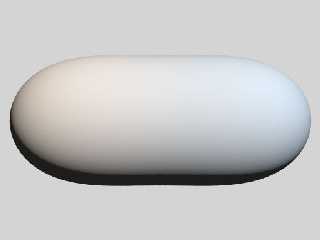
|
 |
|  |
|  |
|
 |
|
 |
|  |
|  |
|
 |
In article <3DB14ACC.DC82D0CD@dcs.gla.ac.uk>,
John Williamson <wil### [at] dcs gla gla ac ac uk> wrote:
> Hmm, that's _very_ counterintuitive with standard blobs! Here's a quick
> replacement with exp blobs. I just copied the values straight in, and it
> seems to work fairly sensibly. I had to fake the texture with a x
> gradient though.
Here's two versions with the new polynomial (and a tweaked threshold,
the blobs didn't connect with the one given). It doesn't have the odd
bulge in the middle (see my other example image for another example),
but it isn't as smoothed over as the exponential blobs (with some
adjustment, it can get closer to that shape...see the second image,
which had radii of 2 and strengths of 1). I didn't bother trying to fake
the texture.
I'll be adding support for both versions to my patch. (the exponential
blobs will be slower because they are unbounded, but still faster than a
user defined function)
--
Christopher James Huff <cja### [at] earthlink uk> wrote:
> Hmm, that's _very_ counterintuitive with standard blobs! Here's a quick
> replacement with exp blobs. I just copied the values straight in, and it
> seems to work fairly sensibly. I had to fake the texture with a x
> gradient though.
Here's two versions with the new polynomial (and a tweaked threshold,
the blobs didn't connect with the one given). It doesn't have the odd
bulge in the middle (see my other example image for another example),
but it isn't as smoothed over as the exponential blobs (with some
adjustment, it can get closer to that shape...see the second image,
which had radii of 2 and strengths of 1). I didn't bother trying to fake
the texture.
I'll be adding support for both versions to my patch. (the exponential
blobs will be slower because they are unbounded, but still faster than a
user defined function)
--
Christopher James Huff <cja### [at] earthlink net>
http://home.earthlink.net/~cjameshuff/
POV-Ray TAG: chr### [at] tag net>
http://home.earthlink.net/~cjameshuff/
POV-Ray TAG: chr### [at] tag povray povray org
http://tag.povray.org/ org
http://tag.povray.org/
Post a reply to this message
Attachments:
Download 'newblob1.jpg' (4 KB)
Download 'newblob2.jpg' (3 KB)
Preview of image 'newblob1.jpg'
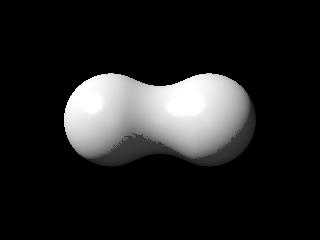
Preview of image 'newblob2.jpg'
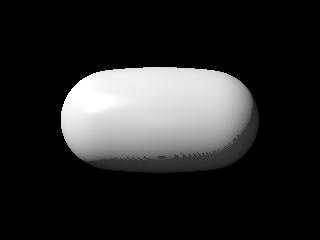
|
 |
|  |
|  |
|
 |
|
 |
|  |
|
 |




![]()